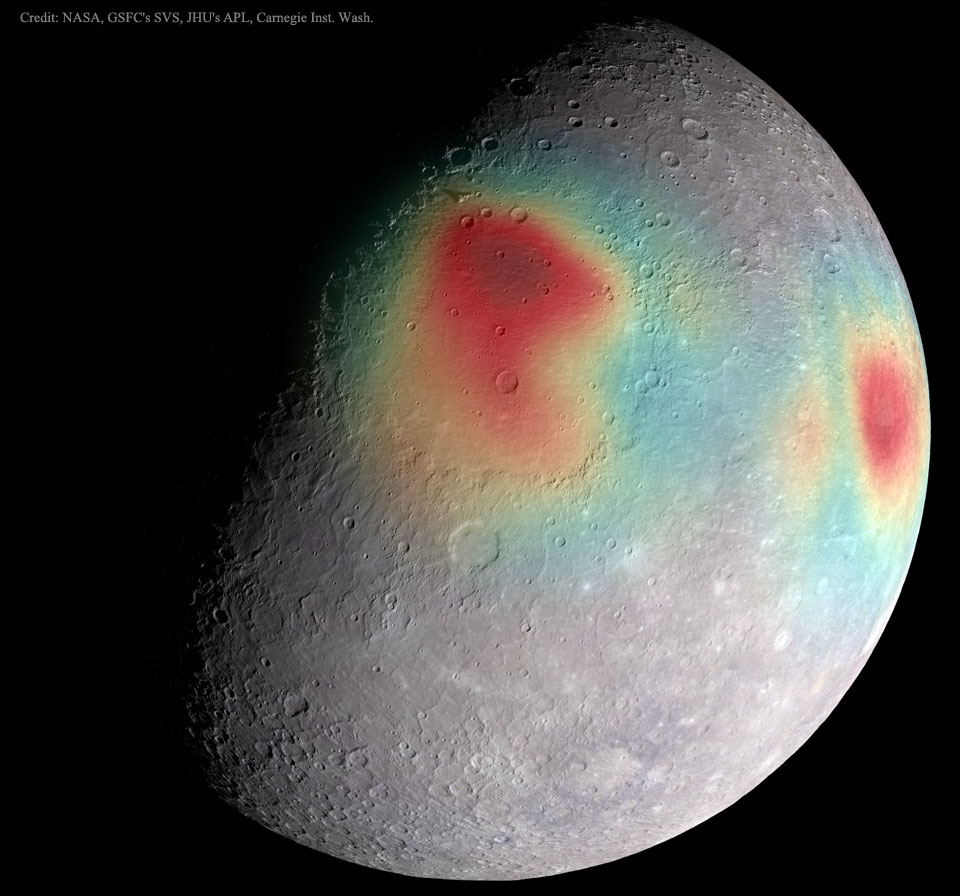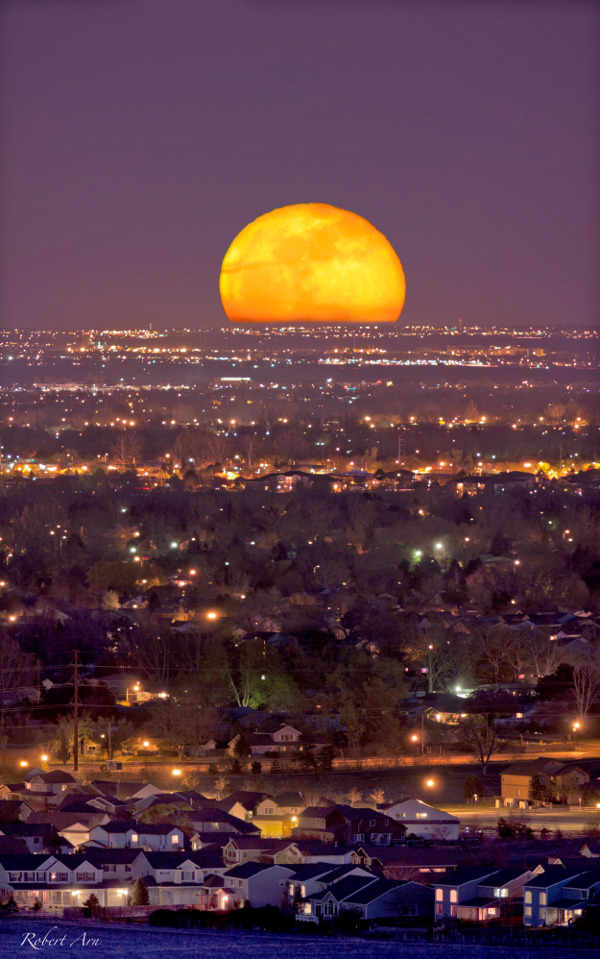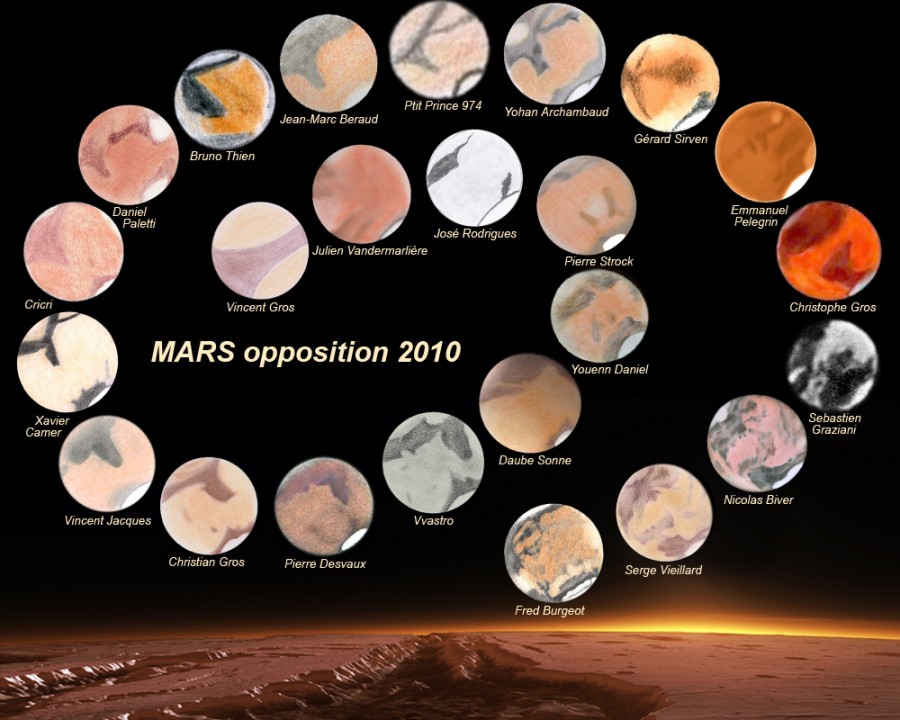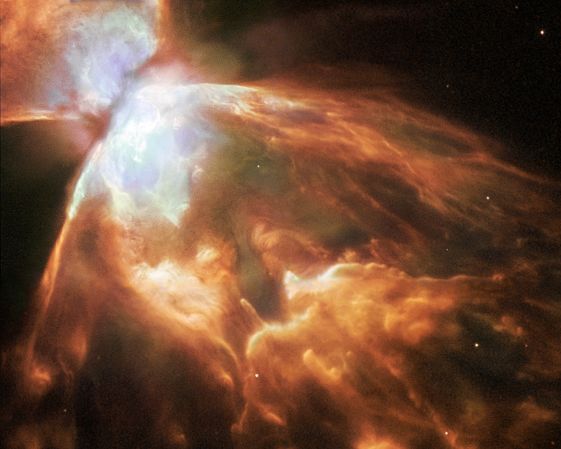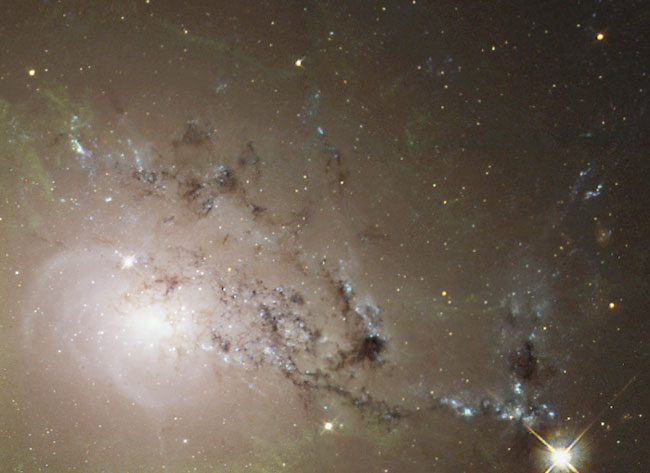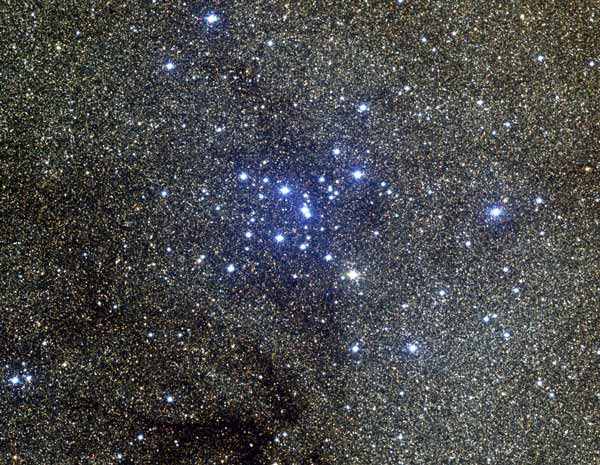| << Previous | Index | Next >> |
2015 What's that under the surface of Mercury? The robotic MESSENGER spacecraft that had been orbiting planet Mercury for the past four years had been transmitting its data back to Earth with radio waves of very precise energy. The planet's gravity, however, slightly changed this energy when measured on Earth, which enabled the reconstruction of a gravity map of unprecedented precision. Here gravitational anomalies are shown in false-color, superposed on an image of the planet's cratered surface. Red hues indicate areas of slightly higher gravity, which in turn indicates areas that must have unusually dense matter under the surface. The central area is Caloris Basin, a huge impact feature measuring about 1,500 kilometers across. Last week, after completing its mission and running low on fuel, MESSENGER was purposely crashed onto Mercury's surface.
2014 How do you calibrate a huge gravitational lens? In this case the lens is the galaxy cluster Abell 383, a massive conglomeration of galaxies, hot gas, and dark matter that lies about 2.5 billion light years away (redshift z=0.187). What needs calibrating is the mass of the cluster, in particular the amount and distribution of dark matter. A new calibration technique has been tested recently that consists of waiting for supernovas of a very specific type to occur behind a galaxy cluster, and then figuring out how much the cluster must have magnified these supernovas through gravitational lensing. This technique complements other measures including computing the dark matter needed to contain internal galaxy motions, to confine cluster hot gas, and to create the gravitational lens image distortions. Pictured above from the Hubble Space Telescope, galaxy cluster A383 shows its gravitational lens capabilities on the right by highly distorting background galaxies behind the cluster center. On the left is a distant galaxy shown both before and after a recent revealing supernova. To date, calibration-quality supernovas of Type Ia have been found behind two other galaxy clusters by the Cluster Lensing And Supernova survey with Hubble (CLASH) project.
2013 Is that a spaceship or a cloud? Although it may seem like an alien mothership, it's actually a impressive thunderstorm cloud called a supercell. Such colossal storm systems center on mesocyclones -- rotating updrafts that can span several kilometers and deliver torrential rain and high winds including tornadoes. Jagged sculptured clouds adorn the supercell's edge, while wind swept dust and rain dominate the center. A tree waits patiently in the foreground. The above supercell cloud was photographed in July west of Glasgow, Montana, USA, caused minor damage, and lasted several hours before moving on.
2012 Rising as the Sun sets, tonight's Full Moon could be hard to miss. Remarkably, its exact full phase (May 6 03:36 UT) will occur less than two minutes after it reaches perigee, the closest point to Earth in the Moon's orbit, making it the largest Full Moon of 2012. The Full Perigee Moon will appear to be some 14 percent larger and 30 percent brighter than a Full Moon near apogee, the most distant point in the elliptical lunar orbit. In comparison, though, it will appear less than 1 percent larger and almost as bright as April's Full Moon, captured in this telephoto image rising over suburban Fort Collins, Colorado, USA. For that lunation, Full Moon and perigee were about 21 hours apart. Of course, if you manage to miss May's Full Perigee Moon, make a note on your calendar. Your next chance to see a Full Moon close to perigee, will be next year on June 23.
2011 Fifty years ago, near the dawn of the space age, NASA controllers "lit the candle" and sent Mercury astronaut Alan Shepard arcing into space atop a Redstone rocket. His cramped space capsule was dubbed Freedom 7. Broadcast live to a global television audience, the historic Mercury-Redstone 3 (MR-3) spacecraft was launched from Cape Canaveral Florida at 9:34 a.m. Eastern Time on May 5, 1961. The flight of Freedom 7 - the first space flight by an American - followed less than a month after the first human venture into space by Soviet Cosmonaut Yuri Gagarin. The 15 minute sub-orbital flight achieved an altitude of 116 miles and a maximum speed of 5,134 miles per hour. As Shepard looked back toward planet Earth near the peak of Freedom 7's trajectory, he could see the outlines of the west coast of Florida, Lake Okeechobe in central Florida, the Gulf of Mexico, and the Bahamas.
2010
2009 When orbiting Saturn, be sure to watch for breathtaking superpositions of moons and rings. One such picturesque vista was visible recently to the robot Cassini spacecraft now orbiting Saturn. In 2006 April, Cassini captured Saturn's A and F rings stretching in front of cloud-shrouded Titan. Near the rings and appearing just above Titan was Epimetheus, a moon which orbits just outside the F ring. The dark space in the A ring is called the Encke Gap, although several thin knotted ringlets and even the small moon Pan orbit there. Cassini and curious Earthlings await the coming Saturnian equinox this summer when the ring plane will point directly at the Sun. Mysterious spokes and telling shadows are expected to become visible that might give away more clues about the nature of Saturn's ring particles.
2008 How do large storms evolve on Saturn? On Earth, a hurricane can persist for weeks, while the Great Red Spot on Jupiter has been in existence for over 150 years. On Saturn, a storm system has now set a new endurance record, now being discernable for greater than three months. Electrical signals were detected from the storm in late November of 2007, while the above image was taken in early March 2008. The storm has roughly the width of planet Earth. Planetary scientists hypothesize that the storm runs deep into Saturn's cloud tops. The above image is shown in exaggerated colors combining violet and green light with light normally too red for humans to see. Visible on the upper right are shadows of Saturn's expansive ring system. Careful inspection will reveal Saturn's small moon Janus just below a ring shadow. Understanding weather on other planets helps atmospheric scientists better understand our Earth's weather. Observers of our Solar System's huge ringed world will be tracking the storm to see how it evolves and how long it will ultimately last.
2007
2006
2005
[imghover6=http://apod.nasa.gov/apod/image/0505/mira_xray_cxc.jpg]http://apod.nasa.gov/apod/image/0505/mira_ill4_cxc.jpg[/imghover6]Credit: X-ray Image: M. Karovska (Harvard-Smithsonian CfA) et al., CXC / NASA; Illustration: M.Weiss (CXC)
2004 The bright clusters and nebulae of planet Earth's night sky are often named for flowers or insects, and NGC 6302 is no exception. With an estimated surface temperature of about 250,000 degrees C, the central star of this particular planetary nebula is exceptionally hot though -- shining brightly in ultraviolet light but hidden from direct view by a dense torus of dust. Above is a dramatically detailed close-up of the dying star's nebula recorded by the Hubble Space Telescope. Cutting across a bright cavity of ionized gas, the dust torus surrounding the central star is in the upper left corner of this view, nearly edge-on to the line-of-sight. Surprisingly, minerals including water ice, along with complex hydrocarbon molecules have been detected in this hot star's dusty cosmic shroud. NGC 6302 lies about 4,000 light-years away in the arachnologically correct constellation Scorpius.
2003 In NGC 1275, one galaxy is slicing through another. The disk of the dusty spiral galaxy near the image center is cutting through a large elliptical galaxy, visible predominantly on the lower left. Galaxies can change significantly during a collision like this, with gravitational tides distorting each galaxy and gas clouds being compressed and lighting up with new star formation. Galaxy collisions occur in slow motion to the human eye, with a single pass taking as much as 100 million years. NGC 1275 is a member of the Perseus cluster of galaxies that lies about 230 million light years away toward the constellation of Perseus. Each galaxy spans about 50,000 light years across. The above picture is a composite of images taken by the Hubble Space Telescope in 1995 and 2001.
2002 M7 is one of the most prominent open clusters of stars on the sky. The cluster, dominated by bright blue stars, can be seen with the naked eye in a dark sky in the tail of the constellation of Scorpius. M7 contains about 100 stars in total, is about 200 million years old, spans 25 light-years across, and lies about 1000 light-years away. This color picture was taken in 1995 at the Burrell-Schmidt Telescope at Kitt Peak National Observatory in Arizona. The M7 star cluster has been known since ancient times, being noted by Ptolemy in the year 130 AD. Also visible is a dark dust cloud near the bottom of the frame, and literally millions of unrelated stars towards the Galactic center.
2001 Forty years ago today (May 5, 1961), at the dawn of the space age, NASA controllers "lit the candle" and sent Alan Shepard arcing into space atop a Redstone rocket. The picture shows the pressure-suited Shepard before launch in his cramped space capsule dubbed "Freedom 7". Broadcast live to a global television audience, the flight of Freedom 7 - the first space flight by an American - followed less than a month after the first human venture into space by Soviet Cosmonaut Yuri Gagarin. Freedom 7's historic flight was suborbital, lasting only about 15 minutes, but during it Shepard demonstrated manual control of his capsule. Naval aviator Shepard was chosen as one of the original seven Mercury Program astronauts. He considered this first flight the greatest challenge and actively sought the assignment. Shepard's career as an astronaut spanned a remarkable period in human achievement and in 1971 he walked on the moon as commander of the Apollo 14 mission. A true pioneer and intrepid explorer, Alan Shepard died in 1998 at age 74.
2000 Today, all five naked-eye planets (Mercury, Venus, Mars, Jupiter, Saturn) plus the Moon and the Sun will at least approximately line-up. As viewed from planet Earth, they will be clustered within about 26 degrees, the closest alignment for all these celestial bodies since February 1962, when there was a solar eclipse! Such planetary alignments are not dangerous, except of course that the Sun might hurt your eyes when you look at it. So it might be easier to appreciate today's solar system spectacle if <="" a="">you use a space-based coronagraph ... like the LASCO instrument onboard the SOHO observatory. In this recent LASCO image, an occulting disk supported by a structure seen projecting from the lower left blocks out the overwhelming sunlight. It shows three of the planets along with the Sun's location and bright solar wind regions against a background of stars, but Mars and Venus are unfortunately outside LASCO's roughly 15 degree field of view. The horizontal bars through the planets are digital image artifacts. And what about the Moon? The SOHO spacecraft is positioned well beyond lunar orbit where its view of the Sun is never interrupted by the Moon.
1999 As the Voyager 1 spacecraft headed out of our Solar System, it looked back and took a parting family portrait of the Sun and planets. From beyond Pluto, our Solar System looks like a bright star surrounded by faint dots. In the above picture, the Sun is so bright it is blocked out for contrast. The innermost dots visible, labeled E and V for Earth and Venus, are particularly hard to discern. Gas giants Jupiter (J) and Saturn (S) are much more noticeable. The outermost planets visible are Uranus (U) and Neptune (N). Each planet is shown labeled and digitally enhanced in an inset image. Voyager 1 is only one of four human-made objects to leave our Solar System, the other three being Voyager 2, and Pioneer 10 and Pioneer 11.
1998 What's happening behind those trees? Aurora. This picture was taken at midnight near Fairbanks, Alaska, and captures familiar trees, common clouds, and a glowing sky markedly different than a sunset. Particularly strange is the green auroral ring caused by ionized oxygen high in the Earth's atmosphere. The small water droplets composing clouds reflect and absorb aurora light, giving clouds a reddish tinge. The above picture was taken on September 20th of last year. In the next few years the Sun will reach the most active part of its 11 year cycle, meaning more puffs of high energy solar particles will be released, and more spectacular auroras will occur when these particles strike the Earth.
1997 A famous star cluster and observatory highlight this picture of Comet Hale-Bopp. Taken last week from the observatory summit of Hawaii's Mauna Kea Volcano, the dome of the new 10-meter Keck II telescope appears silhouetted on the lower left. Comet Hale-Bopp is visible on the upper right, and the Pleiades star cluster is visible below the comet. Normally sunset and clouds are to be avoided when making astronomical observations, but Comet Hale-Bopp is not a normal astronomical object. In fact, were it cloudless, Professor Keel would be inside NASA's nearby IRTF dome preparing to observe something else. Comet Hale-Bopp continues to look impressive, although it is fading and moving towards the south.
1996 What would the night sky look like if you lived on a planet near the center of a galaxy? Now imagine that this galaxy houses a black hole billions of times more massive than a star. From this spectacular vantage point, the sky might look like the above illustration. This drawing is based on recent observations of the center of NGC 4261, made by the Hubble Space Telescope. Results indicate that a disk of dust 800-light years wide surrounds the black hole. The hypothetical planet depicted above lies within this disk. The black hole itself heats gas to white-hot temperatures, generating light that is reddened when reflected off the dust. Jets shoot off from the poles of the black hole, perpendicular to the disk. However, friction with the dust and gas would cause planets near the black hole to spiral in and disappear forever. NASA has recently announced a new initiative to search for Earth-like planets in our Galaxy.
| << Previous | Index | Next >> |
